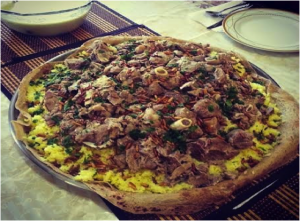Amman, Jordan – 1998
I joined my family in the dining room, noticing immediately that there were no chairs at the table. Where did they go?
Pondering, I became distracted by the center of the dining table, mesmerized by a massive, round dish, called sider, towering with rice and lamb. It was time to feast. Everyone took their spots surrounding the sider, waiting to begin.
Standing next to my father, I asked him where all the plates and cutlery were.
He smiled and said, “We eat mansaf with our hands, habibty.”
HANDS? My entire life, I had been taught to eat only with a fork and knife and here I was, at eight-years-old, being told that I was now allowed to eat with my hands. I was ecstatic to get my hands dirty and witness my always-poised father eat with his hands as well.
This was a pivotal moment in my life: I was not only learning that the national dish of Jordan is mansaf, but also learning how to be a “real” Jordanian. I was loving mansaf more with every anticipatory moment. The introduction to my true heritage had officially begun!
Mansaf is an elegantly simple dish that can still take years to perfect. It is comprised of a thin layer of shraak bread lining the bottom of the sider, covered by pounds of rice and the finest lamb, all sprinkled with a layer of pine nuts.
I waited impatiently, wondering why no one was eating yet. Suddenly, everyone turned to the entrance of the dining room as my aunt walked in carrying a massive bowl of what looked like soup.
My father said, “That is jameed… the best part.”
I later learned that jameed is dehydrated yogurt that is hardened into small balls and reconstituted when preparing mansaf.
My aunt gracefully poured the jameed over the sections we each claimed as our own. The pile of rice soon began to absorb the jameed, bubbling with flavor. Now this was a new wrinkle my eight-year-old self was pondering – how should I begin? Noticing my hesitance, my father quickly scooped the jameed-covered rice with his fingers, along with a tender piece of lamb and bread and fed me my first bite of mansaf. I closed my eyes, immersed in the flavours.
Now I could say that I was a real Jordanian.
Adding to my experience, I learned the technique of eating mansaf with my hands. The rice must be molded into perfectly-sized balls with the right hand only, as the left hand is held behind your back, keeping to the hygienic norms of our culture. The scooping and molding of the rice require only three fingers – your thumb, index and middle fingers.
After taking a bite, a slight shake of the wrist wipes off any rice remaining on the right hand. Finish off the bite by licking your fingers.
Mansaf, I think I love you.
Mansaf Ingredients:
- 2 lbs of lamb pieces on the bone
- Shraak bread
- 2 large containers of plain yogurt
- 1 large white onion, finely chopped
- 1 to 3 strands of saffron
- 1 tbsp of black pepper seeds
- ½ tsp of salt
- 2 tbsp butter
- 2 cups of fired nuts (almonds and/or pine nuts)
- 1/2 tsp ground turmeric (for the rice)
- 4 cups of cooked white rice
- 4 whole cardamom seeds
- 2 bay leaves
- 2 tsp mistka
- 2 small cinnamon sticks
- 2 whole cloves
Jameed Ingredients:
- Goat milk
- Traditional milk churn or goat skin bag called shakwa to separate the butterfat
- Cheese cloth to strain the yogurt
- Salt to aid in the dehydration process
Directions to prepare the mansaf and jameed (from my sister, Lana Al Omari):
- Wash the meat and drain excess water.
- Blend the jameed and yogurt in a blender and then heat on the stove on medium, stirring continuously until it boils. This usually takes about 20-30 minutes. Add salt and tumeric to taste. This mixture will appear somewhat thick.
- Cut a few pieces of onion and add to the pot with the meat. Add hot water, cover and simmer for 2 hours (1 hour if using a pressure cooker) until the meat is tender.
- Once the jameed has boiled, turn off the stove and leave uncovered. Start cooking the rice. Add salt and turmeric to taste.
- Strain the meat liquid into the jameed to make it thinner and place the meat in the jameed to cook for another 10 minutes.
- In a big round tray (sider), place the shraak, then the rice and next the meat on top.
- Fry the pine nuts and cut some parsley finely to sprinkle on top of the meat and rice.
- Strain the jameed into a bowl and place beside the sider.
—
Read more Food, Love, Memories columns, here. Have a submission? More information, here.
Alya Ibrahim \ˈAll-ya Eeb-ra-him\ noun [Synonym: Cultural Chameleon] is a Muslim-American who grew up in Dubai with a Jordanian father and a French/Italian mother. Alya currently lives in Singapore and works as a Project Analyst for Johns Hopkins Singapore. She graduated from Georgetown University in 2014 with a Master’s Degree in Health Systems Administration. She is a global nomad who hopes to improve the health care industry in the Middle East. In her free time, she enjoys exploring culture through food and dancing, and loves sunflowers and chips.













